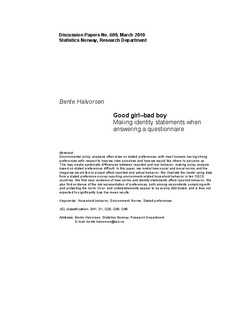Good girl–bad boy : making identity statements when answering a questionnaire
| dc.contributor.author | Halvorsen, Bente | |
| dc.date.accessioned | 2010-11-04T13:18:43Z | |
| dc.date.available | 2010-11-04T13:18:43Z | |
| dc.date.issued | 2010 | |
| dc.identifier.issn | 0809-733X | |
| dc.identifier.uri | http://hdl.handle.net/11250/179949 | |
| dc.description.abstract | Environmental policy analyses often draw on stated preferences, with most humans having strong preferences with respect to how we view ourselves and how we would like others to perceive us. This may create systematic differences between reported and real behavior, making policy analysis based on stated preferences difficult. In this paper, we model how social and moral norms and the image we would like to project affect reported and actual behavior. We illustrate the model using data from a stated preference survey reporting environment-related household behavior in ten OECD countries. We find clear evidence of how norms and identity statements affect reported behavior. We also find evidence of the misrepresentation of preferences, both among respondents complying with and protesting the norm. Over- and understatements appear to be evenly distributed, and is thus not expected to significantly bias the mean results. | en_US |
| dc.language.iso | eng | en_US |
| dc.publisher | Statistics Norway, Research Department | en_US |
| dc.relation.ispartofseries | Discussion Papers;609 | |
| dc.subject | Household behavior | en_US |
| dc.subject | Environment | en_US |
| dc.subject | Norms | en_US |
| dc.subject | Stated preferences | en_US |
| dc.subject | Miljø | en_US |
| dc.subject | Normer | en_US |
| dc.subject | JEL classification: B41 | en_us |
| dc.subject | JEL classification: D1 | en_us |
| dc.subject | JEL classification: Q28 | en_us |
| dc.subject | JEL classification: Q38 | en_us |
| dc.subject | JEL classification: Q48 | en_us |
| dc.title | Good girl–bad boy : making identity statements when answering a questionnaire | en_US |
| dc.type | Working paper | en_US |
| dc.subject.nsi | VDP::Social science: 200 | en_US |
| dc.source.pagenumber | 63 | en_US |
Tilhørende fil(er)
Denne innførselen finnes i følgende samling(er)
-
Discussion Papers [1002]
